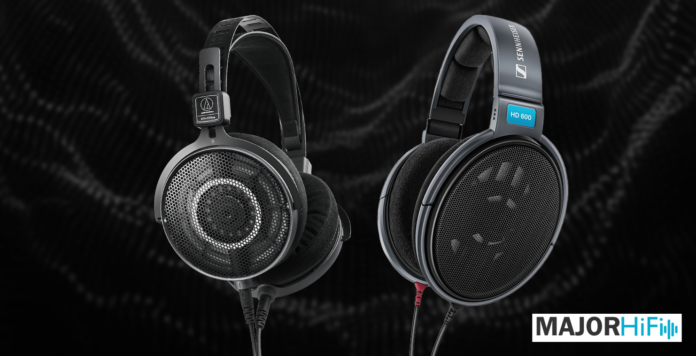Few open-back studio headphones are as iconic as the Sennheiser HD 600. However, Audio-Technica’s ATH-R70xa makes a case as a compelling alternative, offering a unique take on neutral audiophile sound. Both headphones are designed for critical listening, mixing, and mastering, but they bring distinct differences in comfort, soundstage, and tonal balance. Let’s break down how the Audio-Technica ATH-R70xa and Sennheiser HD 600 stack up against each other in terms of design, sound quality, and overall performance. Whether you’re an audio professional or a dedicated enthusiast, this comparison should help you determine which model best suits your needs.
What You Get
| Audio-Technica ATH-R70xa | Sennheiser HD 600 |
|
|
Look & Feel
The Audio Technica R70xa and the Sennheiser HD 600 are different headphones in terms of look, but they have similar structures for their open-back designs. Holding both headphones in your hands will reveal a huge difference right off the bat. The R70xa is super light, almost weightless. I would never consider the HD 600 to be a particularly heavy set of headphones, but any pair of headphones will be heavier compared to the R70xa. This has a huge impact on the headphone’s comfort quality, as wearing the R70xa almost feels like nothing. Its earpads and headband add no extra pressure and make long listening sessions a breeze. There’s significantly more clamp force and pressure wearing the HD 600, however, some might prefer its tight grasp and supportive, snug fit.
Design
These are both dynamic driver headphones with similarly sized units. The Audio Technica R70xa sports a 45mm driver, while the Sennheiser HD 600 uses a 42mm driver. Both configurations are made to have very high impedances and are meant to be used with suitable headphone amplifiers that can push these driver to their full potential. Having used the HD 600 a lot over the years, most budget to mid-level amplifiers can push it, and the time spent listening to the R70xa makes me think the same. An iFi Zen DAC or Can will easily drive these headphones, and so should most products beyond their price range.
| Audio-Technica ATH-R70xa | Sennheiser HD 600 |
|
|
Soundstage
In terms of instrument depth and sound positioning, both the Audio-Techinca R70xa and the Sennheiser HD 600 will get the job done. When A/B testing each headphone, I think the R70xa has a significant leg up when it comes to width and spaciousness. It makes the HD 600 feel very linear in comparison, as the R70xa pushes more outward opening up the headspace with a more engulfing display. This doesn’t just act as an immersive property, it makes sounds appear more individualized in the mix. While both headphones have no issue with localization, it feels like there’s more separation and distinction when listening to the R70xa. The HD 600 still stands tall in terms of its accurate imaging, but the R70xa brings a clearer dimension to the sound.
Low End
This is where the Sennheiser HD 600 usually wins most people over. Its bass is very deep and resonant, punching hard but maintaining balance in the mix. When switching over to the R70xa, some of that solidity goes away, but it brings its own dynamism in response. You might prefer this sound signature for its more technical aspects and greater finesse, but the HD 600 is still the stronger choice for bass assessment in my opinion.
Mids
Both the Audio Technica R70xa and the Sennheiser HD 600 feature great resolution in their midrange frequencies. I would consider them almost equals in terms of being candidates for monitoring and mixing. They both showcase great clarity with instruments, effects, and vocals, with each headphone displaying particular quirks. While the timbral quality of both headphones is relatively neutral, there’s more textural definition coming through the R70xa compared to the HD 600. The HD 600 is more raw with its mids in that regard, which has its own advantages for more precise mixing. Either way, it doesn’t seem like you can go wrong here if midrange clarity is a priority for you.
Highs
If you’re not a fan of brightness, the R70xa is considerably more relaxed in its high frequencies compared to the HD 600. While it still does its best to resolve details, the R70xa is much softer toward treble than the HD 600, which doesn’t shy away from spikes of high-frequency artifacts. Those who don’t mind brighter details might prefer the HD 600’s more refined shimmer.
Summary
Choosing between the Audio-Technica ATH-R70xa and the Sennheiser HD 600 ultimately comes down to personal preference. If you prioritize a lightweight design with a wider soundstage and relaxed treble, the R70xa is an excellent choice. On the other hand, if you prefer a more snug fit, richer bass, and a slightly brighter, more textured midrange, the HD 600 remains a legendary option. Both headphones deliver exceptional clarity and detail, making them top-tier picks for analytical listening. No matter which one you choose, you’ll be getting a premium open-back experience that stands the test of time.
The Audio-Technica ATH-R70xa and the Sennheiser HD 600 are available at Audio46.
MAJORHIFI may receive commissions from retail offers.








